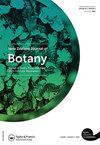新西兰南岛尼尔森/塔斯曼一新种胡氏石笋属(菊科,石笋科)
IF 1.4
4区 生物学
Q4 PLANT SCIENCES
引用次数: 0
摘要
文摘新西兰我们的研究对修订Craspedia(菊科/菊科,Gnaphalieae)导致新物种的识别从尼尔森/塔斯曼,新西兰南岛。胡利瓦石南只生长在皮基基伦加山脉Tākaka山脚下的里乌瓦卡河北支流地区。在形态上与小毛猴相似,但其特征是其更坚固的花萼,倒披针形到几乎线形的叶片,花期后由半球形逐渐变为球形的肾小球,更大且数量更多的小花(每肾小球约200朵),棍棒状的顶端乳头刚毛羽,瘦果的双毛较长,乳头与瘦果的长度<2.1:1。对其形态、分布、生境、生态、物候、词源等方面进行了图解和描述,并对其保护状况进行了评价。本文章由计算机程序翻译,如有差异,请以英文原文为准。
Craspedia huriawa (Compositae/Asteraceae, Gnaphalieae), a new species from Nelson/Tasman, South Island of New Zealand
ABSTRACT Our research towards a revision of New Zealand Craspedia (Compositae/Asteraceae, Gnaphalieae) led to the recognition of a new species from Nelson/Tasman, South Island of New Zealand. Craspedia huriawa occurs only in the area of the Riuwaka River North Branch at the base of Tākaka Hill, Pikikirunga Range. It is morphologically similar to C. minor but is distinguished by its sturdier scapes, oblanceolate to almost linear leaves, glomerules changing gradually from hemispherical to globose after anthesis, larger and more numerous florets (c. 200 per glomerule), clavate apical pappus bristle plumes, longer twin trichomes of the achene, and pappus-to-achene length <2.1:1. We are providing the formal taxonomic treatment together with illustrations and descriptions of its morphology, distribution, habitat, ecology, phenology, and etymology, as well as an assessment of its conservation status.
求助全文
通过发布文献求助,成功后即可免费获取论文全文。
去求助
来源期刊

New Zealand Journal of Botany
生物-植物科学
CiteScore
2.20
自引率
22.20%
发文量
27
审稿时长
>12 weeks
期刊介绍:
The New Zealand Journal of Botany publishes original research papers, review papers, perspectives, short communications, forum articles, letter and book reviews. We welcome submissions relevant to all aspects of the botany, mycology, and phycology of the South Pacific, Australia, South America, and Southern Africa. The journal’s subject matter encompasses biosystematics and biogeography, ecology, physiology, biochemistry, genetics, reproductive biology, structure and development, taxonomy, ethnobotany, palaeobotany, bryology, lichenology, mycology, plant pathology, and phycology.
 求助内容:
求助内容: 应助结果提醒方式:
应助结果提醒方式:


